How Fast Is A Snake
Key Points:
- Strike speed is especially important to the life of a snake. It is the difference between a big dinner or going to bed hungry.
- Ground speed is a little bit less of import than strike speed, as snakes have very practiced camouflage.
- The Sidewinder is the globe's fastest-moving snake.
It's homo nature to presume that our sophisticated bodies with highly adult brains and dexterous digits are the tiptop of evolution, but at that place'due south a reason that snakes have continued to populate our imaginations and our fears throughout history and beyond practically every civilisation. Snakes evolved millions of years before mammals, and they posed a specially dangerous threat to these warm-blooded animals because they were ideal ambush predators: both innocuous and quick. Their form factor allowed them to alloy easily into practically any environment and move swiftly without observe. And that simplicity of blueprint — when combined with their uniquely hinged jaws — produced a predator that could prey on animals that were seemingly well exterior its weight class.
Today, greenish anacondas can consume anything from wild deer to domesticated sheep. But with the introduction of venom, snakes were killing even the largest animals with their bite. An increasing trunk of inquiry indicates that primates developed a more sophisticated sense of sight because of threats from snakes, and nosotros announced to share an innate genetic disfavor to snakes with our swain primates.
In turn, snakes evolved their adaptations, and natural selection tended to prioritize adaptations that maximize that inherent advantage of speed. As pure carnivores who are besides ambush predators, whatever minute amending to strike speed could make the departure between slithering to home with a total belly or potentially being stomped or clawed to death. Ground speed was frequently less important, particularly with species that had the advantage of good cover-up. But it'due south just natural that many snakes saw their environments sharpen their already agile bodies with new advantages. Considering at that place are more than three,000 snake species with populations on every continent except Antarctica, these adaptations are quite diverse. Few of us need to fear death from snakes in the way our ancestors did, but that doesn't make these cold-blooded creatures any less impressive.
Hither are viii of the fastest snakes in the globe.
#8: Blackness Mamba — Africa'due south Fastest Moving Snakes
Ground Speed: 12 Miles Per Hr
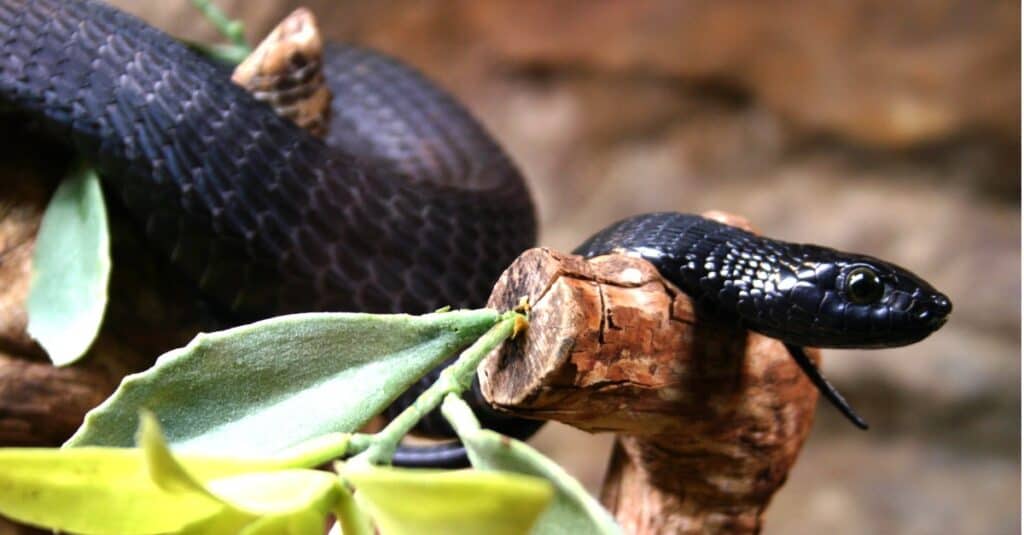
iStock.com/Nicole_Marschall
If a speed of 12 miles per hour doesn't audio too fast compared to the record-setting sidewinder rattlesnake, imagine a 14-foot long serpent barreling towards y'all at that speed. Existence large and highly poisonous leaves these snakes with few natural predators despite inhabiting environments ranging from grasslands to forests. The blackness mamba will typically move in sprints between the footing and depression canopies if possible using a dipping motion that's unique to most snakes and especially stunning given the sheer size of this giant serpent. As long as they can sneak up on information technology, prey like squirrels and mice rarely stand a run a risk. That's because the black mamba combines that exceptional basis speed with a venom poisonous enough to impale a human with just two drops.
#7: Common Death Adder — Australia's Fastest Striking Snakes
Strike Speed: 100 milliseconds
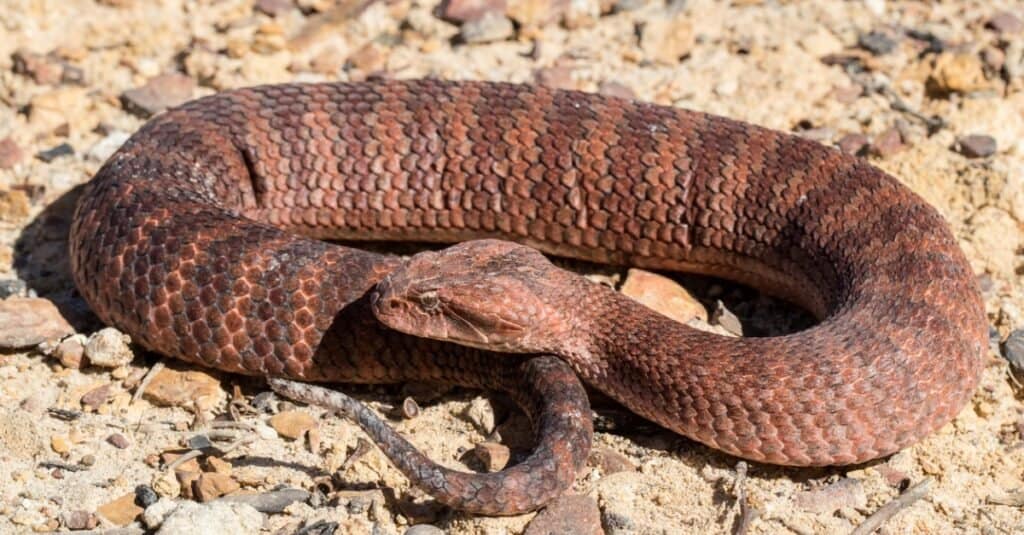
iStock.com/Ken Griffiths
When we mentioned that few people today have to think every day nigh snake bites, we weren't talking almost Australia. The death adder earned its name because it combines adept camouflage, highly toxic venom, and an incredibly fast bite. In just a tenth of a second, the common decease adder tin inject their poison and return their jaw to the active assail position. While over one-half of venomous attacks on humans volition lead to expiry if left untreated, roughly half of bites are dry bites and there is an antivenom. Death adder habitats stretch beyond much of eastern and southern Australia, where their ambush tactics make them a serious threat to prey like rodents. Ironically, information technology could as well contribute to the low incidence of common death adder attacks on humans. Death adders take no interest in humans, and their capable skills every bit hunters mean people will rarely ever sneak upon them.
#6: Southern Black Racer — The Earth's Fastest Not-Venomous Snakes
Ground Speed: viii-10 Miles Per Hr
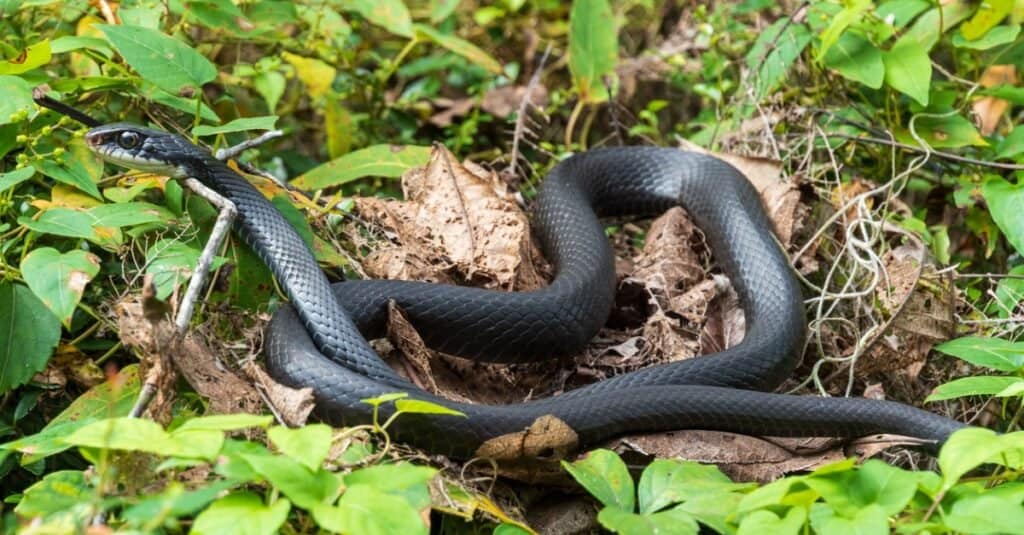
iStock.com/Sunshower Shots
Constrictors are typically some of the slowest serpent species on Earth, but the Southern black racer is too small and its ambitions too big to let information technology to lay in wait and slowly squeeze its prey to death. Instead, it volition use its speed and momentum to pin casualty to the footing or trees and suffocate them to expiry rather than wrapping their bodies entirely effectually. That land speed is a necessity for evading predators every bit well. Racers have developed great talents for climbing and pond as well equally sprinting, merely hawks have developed a keen sense of eyesight and both the momentum and accuracy to pluck a black racer right up. That's not to say that the blackness racer can't put up a fight. Researchers accept observed instances where peachy horned owls were strangled by racers, which in plow died from injuries inflicted by the owl'due south talons.
#five: Yellow-Bellied Sea Snake — The Fastest Snakes in the H2o
Speed on Water: 2.5 Miles Per Hour
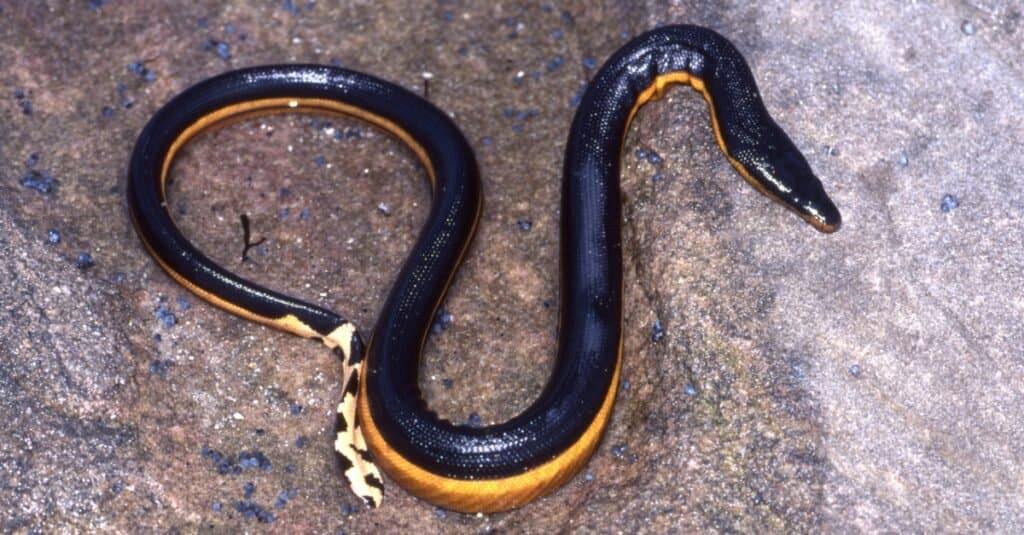
Ken Griffiths/Shutterstock.com
All snakes are capable of swimming, but the yellow-bellied sea serpent is one of several species that have adjusted to live their whole lives in the water. Its yellow and blackness pattern ensures it will stand out distinctly on the waves, but that seems to be of little issue to this ophidian which has no observable predators. They also take the widest distribution of any other snake species, with habitats expanding beyond both the Pacific and the Indian Ocean. Still, it's rare for humans to run across one thanks to the deeper waters in which they adopt to swim. That's a proficient affair, as sea snake poison is highly venomous. The yellow-bellied bounding main snake uses to chase prey consisting almost entirely of fish, and they've adapted to the briny waters they inhabit thanks to an ingenious evolution that allows it to filter freshwater from the saline ocean surface.
#4: Rex Cobra — The Snakes With the Fastest Killing Poison
Time to Impale a Human being: xxx Minutes

iStock.com/takeo1775
The longest venomous serpent in the world is such a lethal killer that they've taken to making other cobras their prey. Their venom is a unique blend of different toxins — but they can inject roughly a quarter of an ounce into their victims with their needle-sharp teeth. Few animals have immunity from this toxin, meaning that the king cobra has few natural enemies. One exception is the mongoose, a feisty little mammal that's known for facing downwards the king cobra. Mongoose is typically 3 feet long, while rex cobras can reach a staggering length of 18 feet. Mongoose isn't immune to the toxin that cobras produce, but they exercise take a resistance that allows them to stay in the fight fifty-fifty if they're a bit. Both animals are lightning quick, and a fight on land could become either way.
#iii: Eastern Diamondback Rattlesnake — The Fastest Strike Speed in America
Strike Speed: 2.95 Meters Per Second
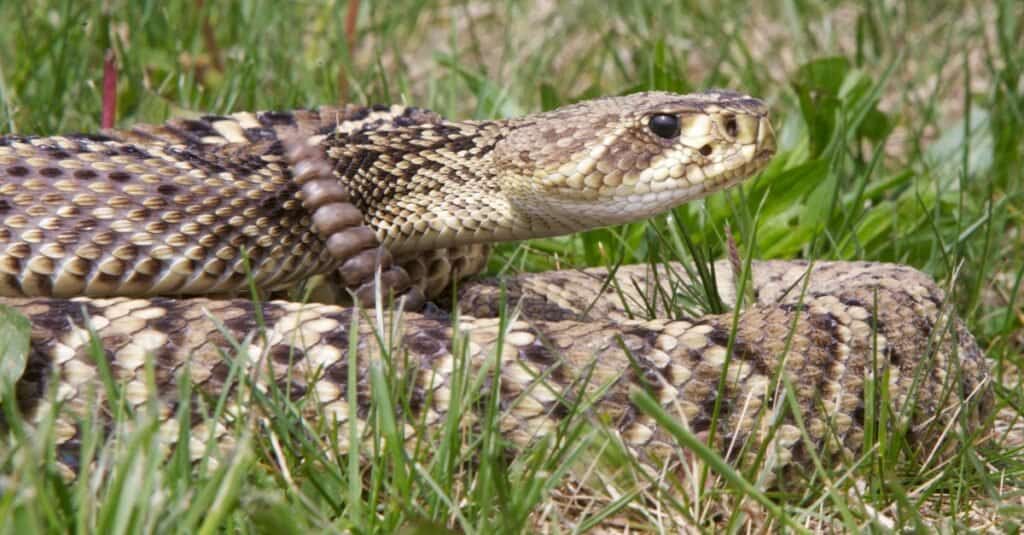
iStock.com/NajaShots
For ambush predators, being able to reach high movement speeds on country isn't ever a necessity, but a fraction of a millisecond can hateful the divergence between life and decease. The Eastern diamondback rattlesnake'south fangs can cover over six feet in less than a second, and information technology can strike out at a length upward to ii-thirds of its unabridged body length. A fight isn't what this snake is looking for. In one case its prey has been injected with poison, the diamondback will permit it wander off to die and follow at its leisure. Mammalian casualty can range in size from mice to rabbits. The rattle serves as a way to warn off potential predators before striking.
#two: Rat Snake — The Fastest Strike Speed of a Nonvenomous Snake
Strike Speed: 2.67 Meters Per Second
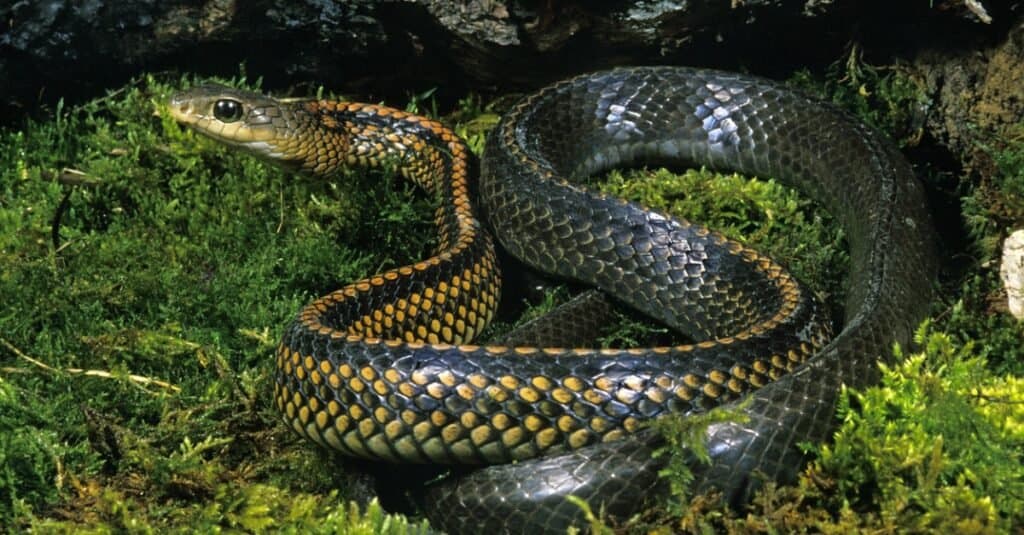
iStock.com/slowmotiongli
Strike speed tin can brand a large difference for venomous snakes that simply demand to inject their prey with a single bite — but the science journalism community is more interested in why a serpent that produces no venom and constricts its prey to death would need a strike speed of nearly that of a diamondback. Information technology may accept contradicted common conceptions about how venomous and nonvenomous snakes developed in tandem, but it makes sense when you consider that the constriction process can kill casualty in just a affair of seconds. Information technology's a reminder that predators and prey are in a constant evolutionary arms race — and information technology'south a race that's often measured in fractions of a second.
#1: Sidewinder — The Globe'southward Fastest Moving Snakes
Ground Speed: 18 Miles Per 60 minutes
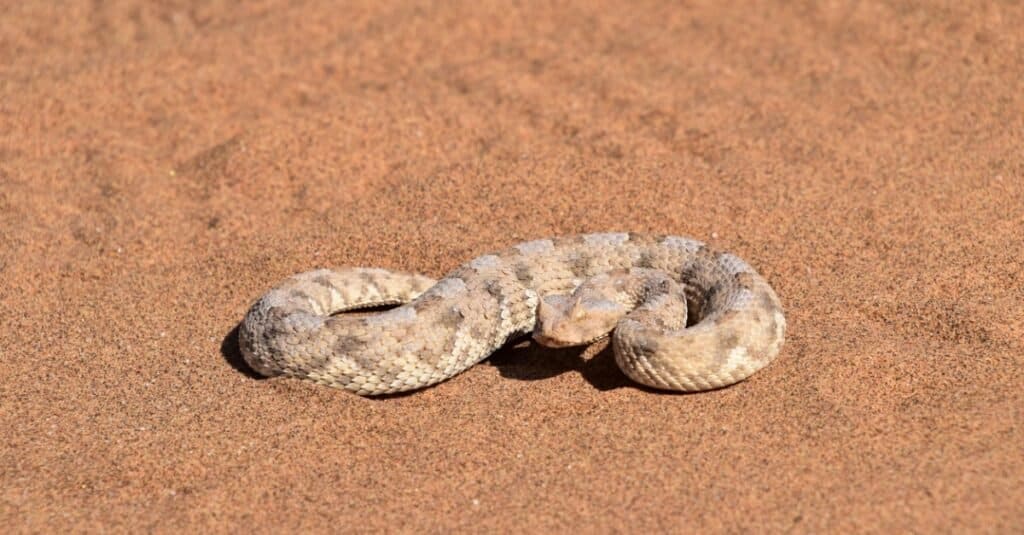
iStock.com/Josh Mitchell
The unique way the sidewinder rattlesnake moves is disquisitional to achieving its incredible meridian speed, but scientists had to build a robot to learn how the fastest snakes on land worked. Nigh snakes benefit from scales that tin can grip surfaces and essentially offer traction in the same way that the treads on a automobile'south tires would. Simply sidewinders occupy the Sonoran and Mojave Deserts throughout Mexico and the American Southwest. Hither, the steep dunes and gritty sand offer the challenge that it would accept a family sedan desert off-road racing. Rather than dig into the sand as researchers originally hypothesized, they instead adapted their angle to press as much of their body confronting the sand as possible. Information technology's a tactic that keeps even the tallest dune stable and lets the sidewinder keep as much "safe on the road" as possible. Ideally, sidewinder rattlesnakes don't even have to chase their prey. They're ambush predators that hibernate in the sand upward to their necks.
Here is a Summary of the eight Fastest Snakes:
- Sidewinder
- Rat Ophidian
- Eastern Diamondback Rattlesnake
- Rex Cobra
- Yellow-bellied Sea Serpent
- Southern Black Racer
- Common Death Adder
- Black Mamba
Next UP…
- Detect the 5 Water Snakes In Georgia There is a lot of water in Georgia, and many h2o-loving snakes.
- Discover x Incredible Serpent Facts. If you love snakes every bit much as we practice yous volition savor these fun facts!
- 7 Snakes that Hunt at Night. Did you know that some snakes are nighttime predators?
Discover the "Monster" Ophidian 5X Bigger than an Anaconda
Every day A-Z Animals sends out some of the most incredible facts in the world from our complimentary newsletter. Want to detect the 10 most cute snakes in the earth, a "ophidian island" where you're never more than than 3 feet from danger, or a "monster" snake 5X larger than an anaconda? And so sign up correct now and you'll start receiving our daily newsletter absolutely free.
How Fast Is A Snake,
Source: https://a-z-animals.com/blog/8-fastest-snakes-in-the-world/
Posted by: hudsonthandsoll.blogspot.com


0 Response to "How Fast Is A Snake"
Post a Comment